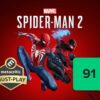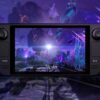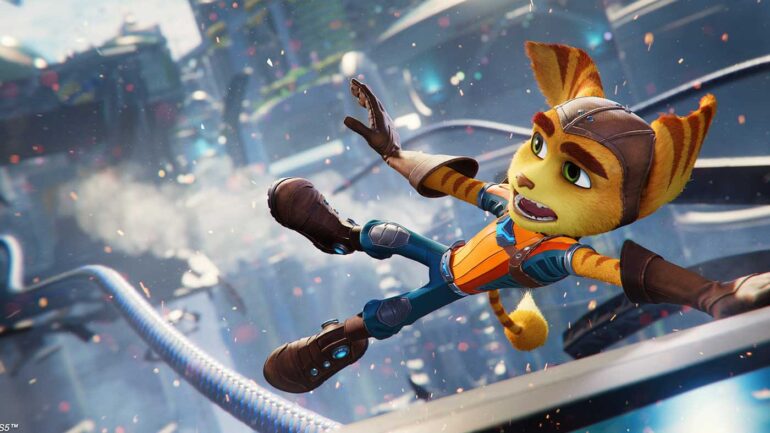Earlier this week I had the privilege of sitting down with Insomniac Games’ Marcus Smith, the Creative Director of Ratchet & Clank: Rift Apart. Marcus has been at the studio for over 15 years and has worked on a number of Ratchet & Clank games as well as Sunset Overdrive, Spider-Man and the Resistance franchise.
RELATED: Ratchet & Clank: Rift Apart Preview – A Big Step Forward
I got to learn more about what makes Ratchet & Clank: Rift Apart a truly next-gen title, how the rifts work, how Rivet plays a major part in the game and a lot of other little details that any Ratchet & Clank fan is going to love to hear before they get hands-on with the game on June 11th.
One of my first observations from watching the hour or so of gameplay is that there seems to be more slower cinematic moments as you go through the level. Was this decision made to give the game a more AAA cinematic feel and to be aligned with Sony’s first-party titles?
Marcus Smith: I don’t think we were calculating that as much as just as a studio we’ve grown, we learned a lot from the development of Spider-Man and really it’s just the team that we’re dealing with who want to explore more depth and emotional depth to our characters. So if you’re seeing that it probably has more to do with the internal world that we’re living in than any sort of agenda from Sony.
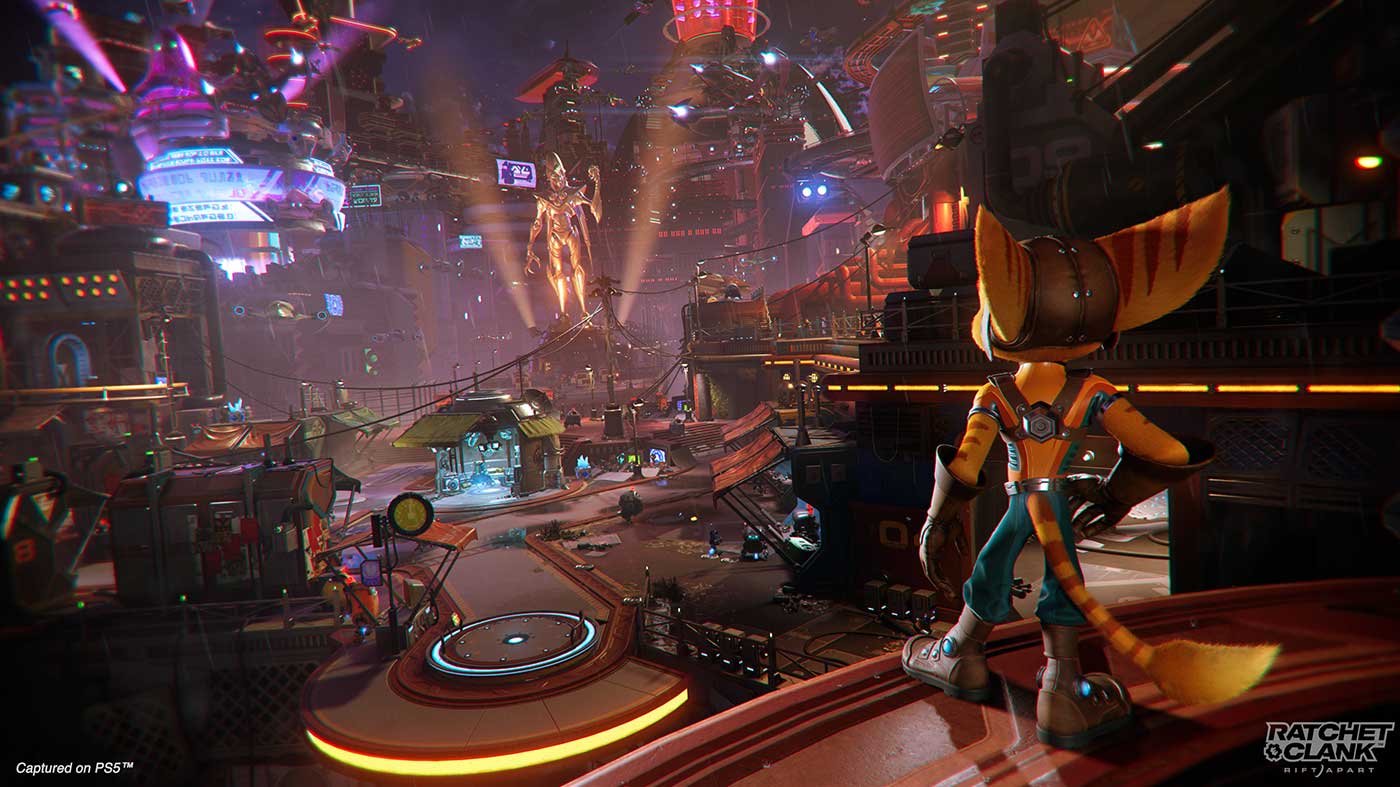
The rifts are obviously a big part of this game. Are there optional rifts or are they all tied to set pieces?
MS: We have a few different aspects of rifts and dimensionality. When we were developing the game, we were trying to come up with ways of using different traversal mechanics, which is the rift tether that we showed, where you’re able to whip yourself from one area of the map to another. We also have places called “pocket dimensions” that are kind of one-off mini-game sort of areas, that are optional and found throughout the world. So you’ll find rifts that you can open up and transport yourself into those. There’s a number of side content. Again, it’s very much like the formula of older Ratchet and Clank franchise games, which is, there is a primary aim which is very campaign driven. But then there is a lot of side content collectables and a variety of side content for people to take on.
Can you go back and forth between rifts or are you sort of always moving forward to the next area through a rift?
MS: It depends. So we showed a segment of gameplay last year in November, where we did what we called a shift sequence where the players are kind of being propelled forward through rift after rift. In those situations, it’s like the world is on shuffle play and the player is having to figure out what to do and how to react. In those cases. It’s all very forward centric. In things like the pocket dimensions you’ll enter them and then if you decide to turn around and go right back out of that rift, you can do that.
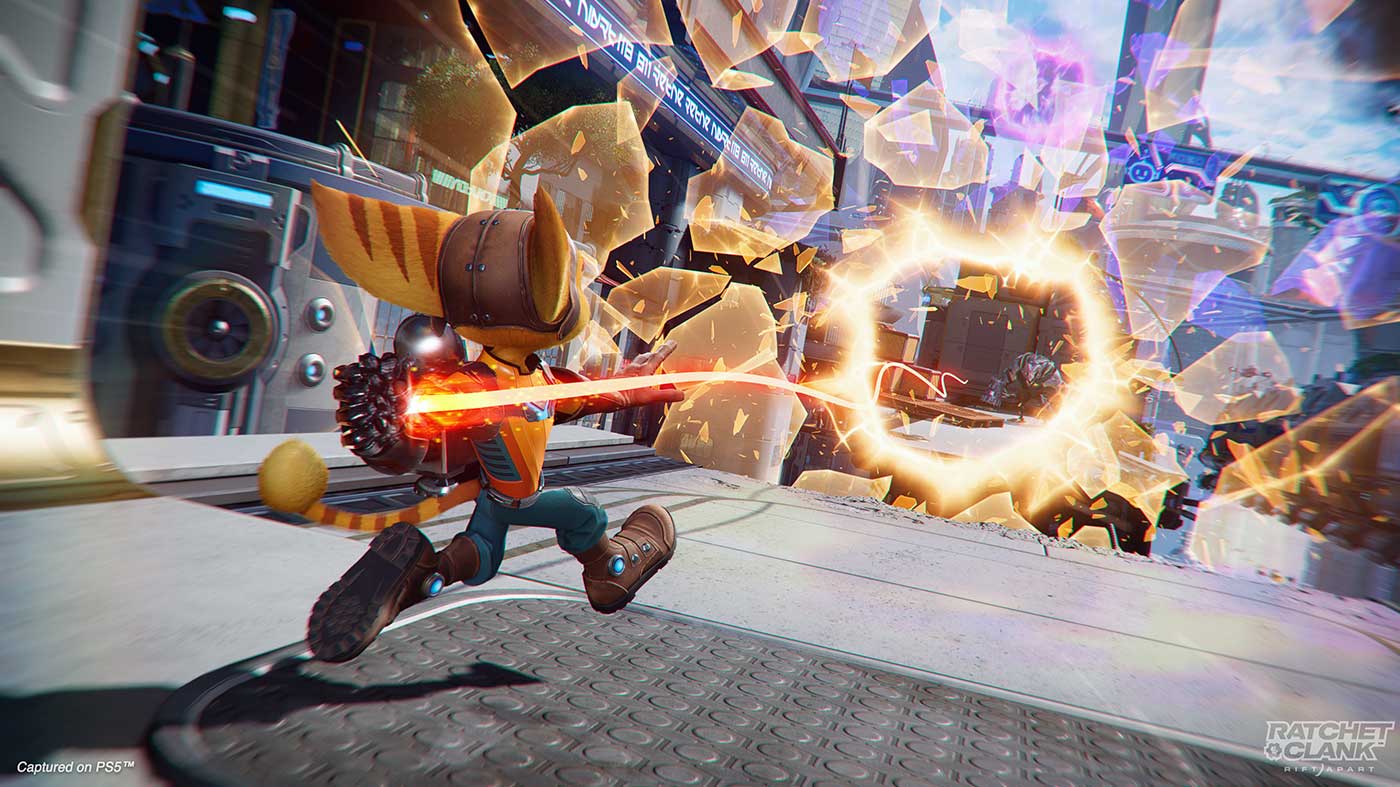
Obviously the weapons are the biggest part of a Ratchet and Clank game. What’s the split between new and returning guns and how do you decide which ones to bring back?
MS: The main thing is we have this idea of what a well-balanced arsenal is based on all the years of games that we have and so we have this with this kind of matrix of what you need. We make sure that players have the the bread and butter shooter, that is a mid-range kind of use anywhere, then we make sure that there are shotgun types that are closer range, just the kind of bread and butter that allows you to strategize in any combat setup. Then of course we have all the very unique weapons and that’s where things need to fit into one of the three categories of being strategically needed or a spectacle or humorous. That’s where things like the Groovytron would come from. In this game, we have the Topiary Sprinkler that turns enemies into topiary statues and we have a few other weapons that are much more humour driven but we basically just have this matrix and we ideate and brainstorm on specific slots.
And we say, for example, might have multiple rapid-fire, overheating type weapons that we think we the player would need towards the end of the game when enemies have progressed a lot higher and then we’ll start prototyping and we’ll see what works and what doesn’t. In this case, we have mostly new weapons. There are only a few returning weapons. Those did fit a slot that we felt was needed and it’s always hard with any sequel in the fact that you’re damned if you do damned, if you don’t. There are people who are very excited to see returning weapons and then what we hear the most out of any fan feedback is we’re tired of seeing weapons come back and back. So we did err on the side of trying to do as many unique new weapons as possible.

Does the power of the PS5 allow you to do things with weapons that you might not have been able to do before? Like the Topiary Sprinkle for instance doesn’t seem like it’d have been possible in earlier gens?
MS: Yeah, I think it would probably have been a lot simpler. The visual effects alone would not have been able to be presented in the way that they are had it not been for the power of the PS5. The haptic feedback of course wouldn’t exist and it’s hard to say because it’s one of those weapons that probably could have been executed, just not nearly as well, whereas there are some other weapons that yeah, just flat out could not have been been done on previous generations.
Weapons upgrades are something that has changed from game to game quite consistently. What model is being used here?
MS: We’re sticking with a model that’s very similar to Ratchet PS4 for our weapon upgrades, which is pretty straightforward for ease of use. We’re focusing on really just making sure that all of the weapons have a nice arc towards their development and that players will be happy when they are leveling up both through usage and through the upgrade system.
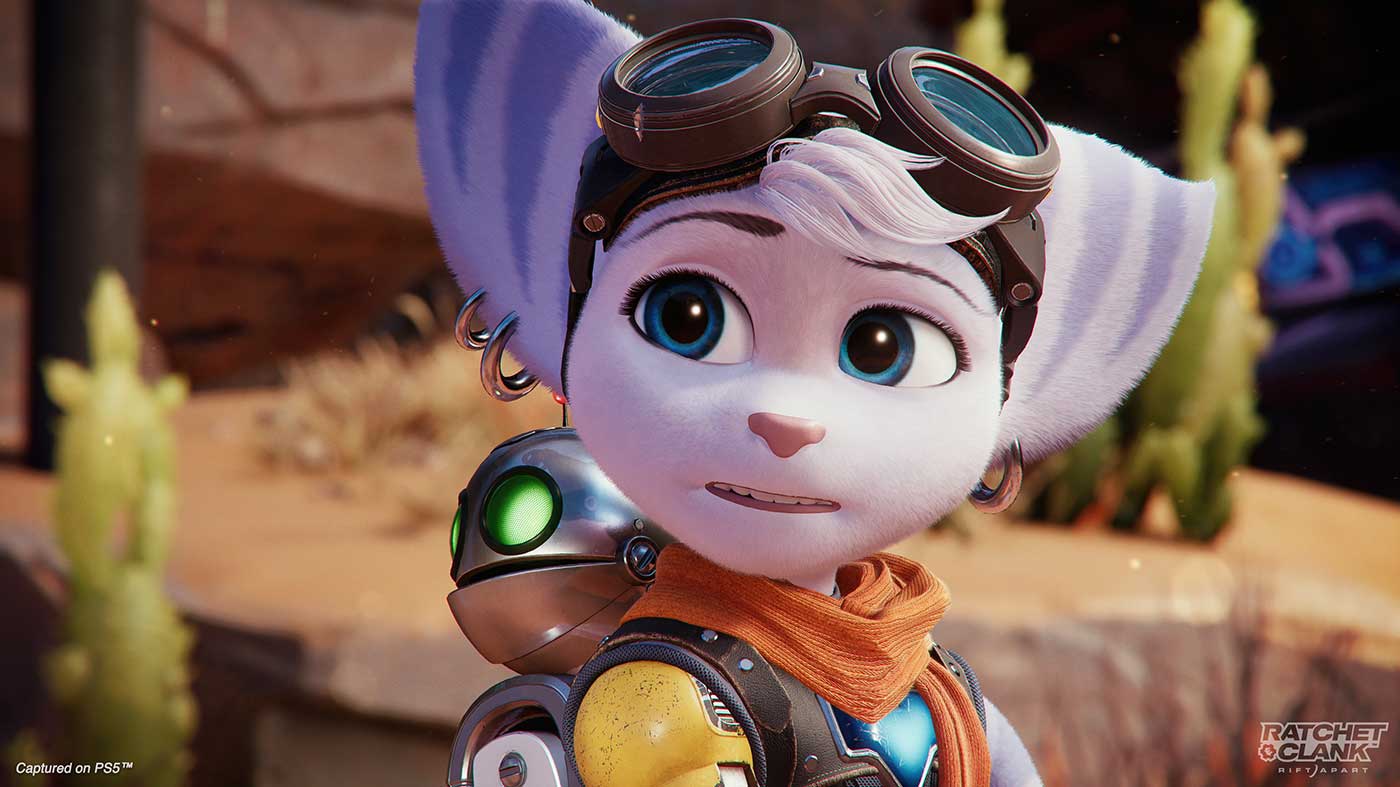
Rivet is Ratchet’s alternate universe counterpart and she has stolen the show since the game was announced. How did she come to be and were there any other ideas on the table during brainstorming?
MS: I think from the very get-go we had a couple of things that kind of came together and dovetailed nicely. One was that we were trying to figure out how do you bring new players to a franchise that has such a long history without everybody needing to know all of the backstories. With games it’s very hard to play older games and we don’t expect everybody to go to YouTube and watch play throughs or anything. So it was then what sort of story could we tell that could bring new players in and also appeal to older players? We started immediately thinking about the old movie, It’s A Wonderful Life where the protagonist gets to see what the world would be like if there was this fundamental difference and that sparked a lot of interest. We started going with this idea of there being another dimension and there is this other-dimensional version of Ratchet, but that Ratchet didn’t have a Clank and didn’t have that experience and how different everything would be if that were the case and from that moment that just spiralled into every decision we made.
We were going back and forth about how different or similar these characters would be in their alternate dimension selves. We decided that ultimately they needed to be true to the characters of who they are but the facts of the world have changed and that’s really the biggest differentiator. Then the other thing that dovetailed into that was we were being brought up to speed about the capabilities of the hardware and we knew that the SSD was going to be extremely fast and streaming was going to be something that we could show off extremely well. That worked really well with the idea of dimensionality and immediately started the hamster wheels turning about flinging players from place to place to place and this damaged fabric of space-time, and all the fun stuff that we could do with that. So, two ideas that kind of came together and worked really well together.
Is there any difference between how Ratchet and Rivet play? I noticed they’ve got some new abilities that they both share?
MS: So between the two Lombaxes, there aren’t any differences and the reason that is originally we had them different and what we noticed right away is that players would get frustrated the moment they hit an issue where they couldn’t use something that one of the other characters had. So, to remove that mental mapping obstacle we made them have the same economy upgrades, so anytime the player invests anything in the character it will continue throughout the rest of the game. That just added to that already set piece of how Ratchet and Clank economy works, which is you want to be upgrading your weapons as the medium loop all the way through the game. So that ended up just being the smarter way to go about making sure that the players are not missing out.
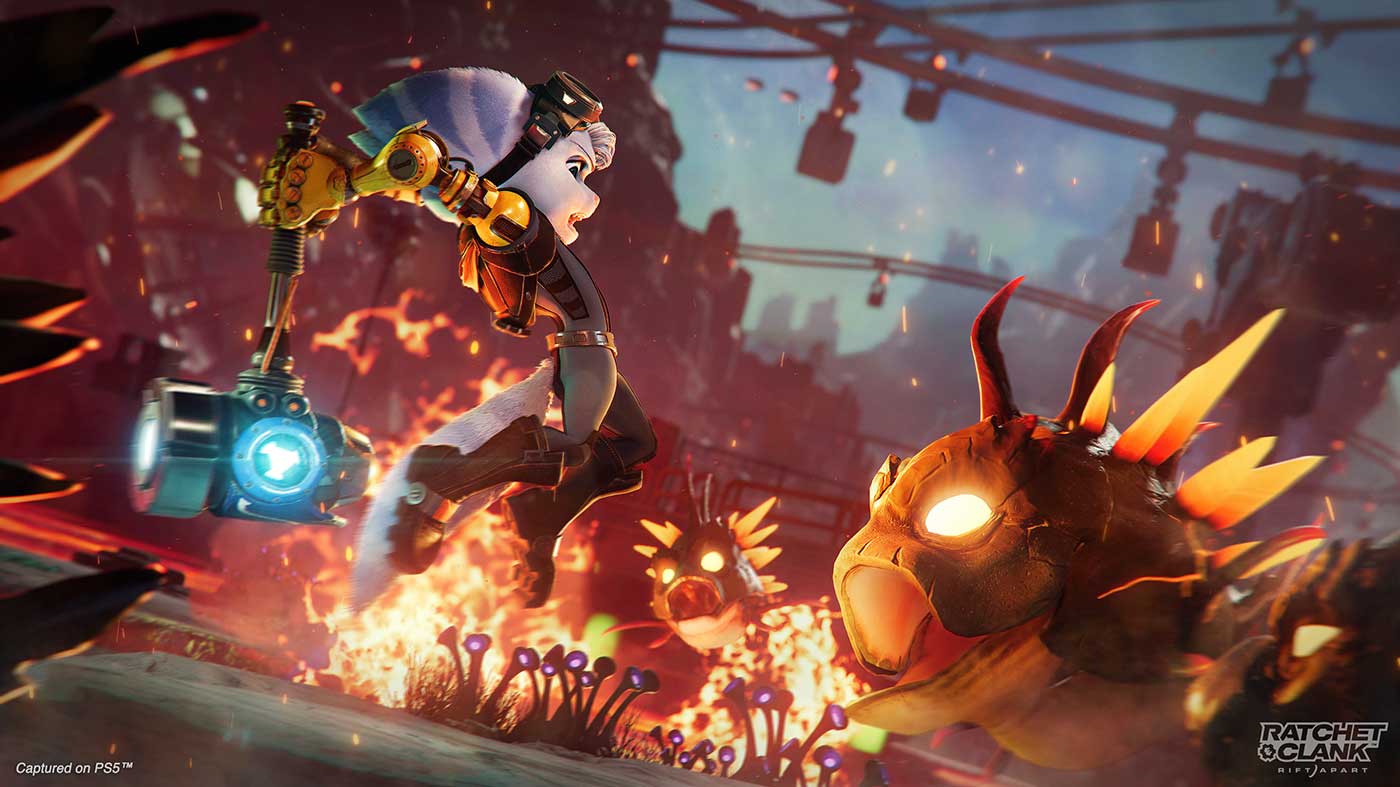
Are the Rivet parts of the game placed throughout the story like Clank segments would have been in previous games or can you choose between the two characters at certain points?
MS: It’s mostly set up by the story dictate. So Ratchet kind of has his storyline, Rivet has her storyline and the player will be experiencing those back and forth. There are moments where you can decide whether you want to do this planet first or this planet first, but those planets themselves will be played by the character that it’s set up to be.
Replayability has always been a big part of Ratchet and Clank games. Even before trophies were a thing I spent so much time when I was younger unlocking skill points and collecting gold bolts. Are they still around in this game?
MS: Yeah, well, it’s funny because skill points were our idea of trophies trophies existed and so those have kind of just became the trophy but yeah, we continue to build on that model of there are collectibles in the world, there are things that we want players to go and find and, and reward exploration. We have pocket dimensions that are places that people can go and find new armour or other rewards. Lots to do beyond just the story campaign.
Obviously rifts are one of the major new elements of the game, but what are some of the core changes that hardcore Ratchet & Clank fans that have played all 10 or more of the games that will notice when they pickup the controller?
MS: I think the traversal elements just lend themselves to flow in a way that Ratchet and Clank maybe hadn’t had and I think the lessons that we learned from Sunset Overdrive and Spider-Man whereas we might’ve just had a hook shot somewhere, now we’re having areas where you can Hook Shot and then use Phantom Dash and then wall run and then rift tether and it flows together really nicely. So when you get the rhythm of it, it just feels great and I think that’s probably the biggest difference between Rift Apart and older franchise entries.
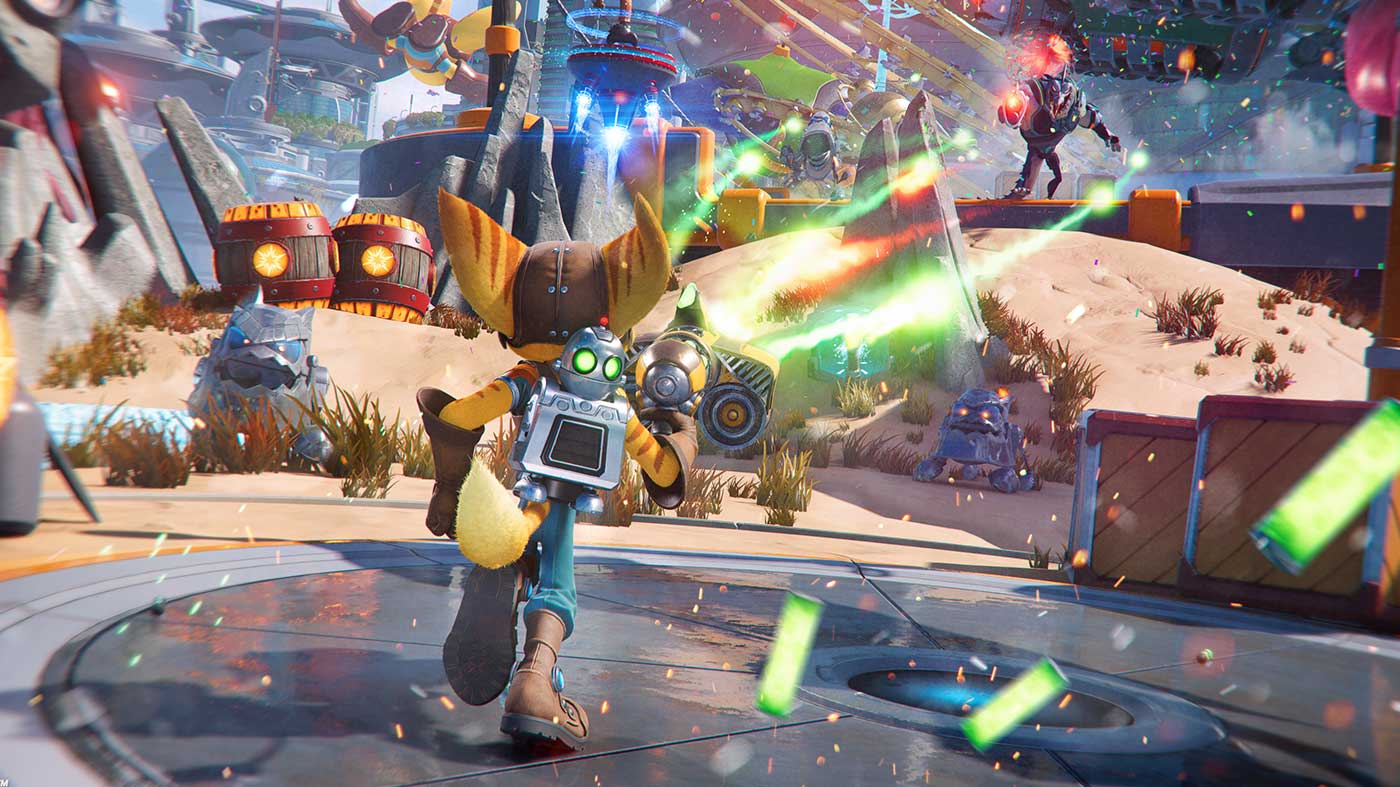
What surprised me when doing a bit of research is that there were six new Ratchet & Clank games on PS3 and only one last gen in the form of a remake on the PS4. Obviously, the team weren’t twiddling their thumbs last-gen, but why was there such a big gap between new games in the series? Was it that the team felt that Ratchet needed a bit of a break and the fact that there’s new hardware?
MS: Yeah, I think it’s a combination of that. There are several things. Usually it has a lot more to do with business and what projects we had lined up previously, in our case with Insomniac, we have two studios one in Durham, North Carolina, and one in Burbank, California and the originally the Durham studio out in North Carolina was making the newer Ratchet games and that was the division of labor was they were continuing to make Ratchet games while we focused on other things in Burbank, but it’s proven to be a much better model for us to all be working on the same games and you know, it’s such a labor of love to work on these Ratchet games. Like so many people work at insomniac because they love Ratchet and Clank. Any opportunity to work on these games will be met with a number of people being very excited internally.
You look at pricing of Ratchet & Clank games and the last game was about $60 Australian whilst the new one is $120 Australian. Does that play in your mind during development and make you look at things like length and what else you could incorporate to make this feel in line with Spider-Man or is it just you developing a game as you would any and letting other parts of the business dictate price?
MS: Yeah, it’s the latter. We focus on making games. I really have no say one way or another about pricing or those sorts of things. For us, it was much more important that we were delivering a full length Ratchet and Clank experience and we haven’t really done that since A Crack In Time on the PS3, so that was the ultimate decision-maker. This was going to be a full-length Ratchet and Clank game and from there, we just needed to make sure that it is definitively a PlayStation 5 version of that, which means better graphics and everything looks, plays and feels better.

Just on that, we touched on it with weapons earlier, but do you think this sort of game and the vision that the team had could have been executed on PS4? Obviously, this is one of the first true PS5 exclusives, but could this game have happened last gen?
MS: No, especially when it comes to shift sequences and whatnot, where we’re going from planet to planet to planet and those would have been tens of seconds of loading time each and that would really break down the flow of that gameplay and throughout the game. There are moments like that, of things that just would have taken longer and would not have been able to be a satisfying player experience.
Ratchet & Clank: Rift Apart releases exclusively on PS5 on June 11th.
